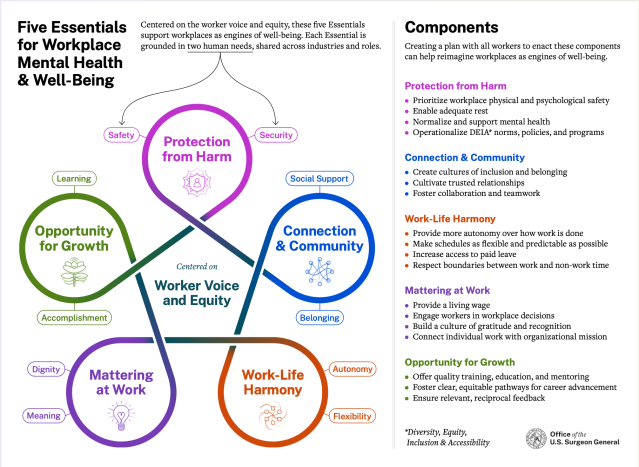Workplace Dynamics
Toxic Workplaces: A Survival Guide
How to navigate toxic leaders, coworkers, and workplace culture.
Posted February 28, 2024 Reviewed by Davia Sills
Key points
- Toxic workplaces cost billions and impact at least 20 percent of workers.
- Find ways to navigate relationships wisely to connect beyond toxic leaders and coworkers.
- Support zero-tolerance policies, inclusivity, and build accountability for toxic behaviors.
- To build in recovery time, detach, seek joy outside of work, and set boundaries.
Toxic workplaces are pervasive—a staggering 56 percent of American workers claim their immediate boss falls within the mildly to highly toxic spectrum. Toxic workplaces cause one in five people to leave their jobs at some point in their careers and even prompt employees to leave their jobs at a rate ten times that of compensation. The economic toll of toxic environments on U.S. employers is estimated to be nearly $50 billion annually, with extremely disengaged employees being roughly 20 percent less productive. The impact on health goes beyond heightened stress, burnout, and mental health issues to physical illnesses. For example, when employees experience injustice in the workplace, their odds of suffering a major disease (including coronary disease, asthma, diabetes, and arthritis) increase by 35 percent.
What constitutes a toxic culture?
Employees identify a culture as toxic when it is marked by disrespect, non-inclusivity, unethical practices, cutthroat competition, and abuse.
Navigating such environments requires resilience and strategic approaches to maintain well-being and productivity. The Office of the U.S. Surgeon General outlines five key areas to focus on to ensure a healthy workplace culture and employee well-being.

Leadership: Rising Above Toxicity
To mitigate the impact of a toxic leader, explore connections with their higher-ups or lateral managers. Participate in special projects with different project managers to diversify your professional network. By broadening your scope, you may find mentors or advocates who can guide you through the challenges. Meeting with other leaders in the organization can also help you suss out areas you may want to transfer to.
Coworkers: Building Bridges Amidst Turmoil
Toxicity amongst your teammates can look like unhealthy conflict, isolation, and bottlenecks. To try to counteract this, seek connections outside your immediate circle. Engage in cross-departmental interactions, whether in-person or virtually. Consider initiating "virtual coffees" to understand different department functions and identify potential allies. Expanding your network beyond the toxic sphere can provide support and insights that prove invaluable.
Organizational Intervention: Setting the Foundation for Change
Organizations play a pivotal role in cultivating a healthy work environment. Implementing zero-tolerance policies for mistreatment, fostering civil interactions, and ensuring accountability are foundational steps. Even if you cannot implement this at an organizational level, if you are a leader, you can implement it within your team. Building a respectful, inclusive, and supportive culture not only removes toxicity but also benefits employees by building engagement and productivity.
Self-Preservation: Separating Issues and Maintaining Dignity
In the midst of toxicity, it's crucial not to get caught up in the drama. Separate yourself from the negative energy and focus on your work. Prioritize your well-being by cultivating a positive mindset and seeking out activities that bring you joy outside of the workplace. Engage in hobbies, pursue learning opportunities, and build relationships outside the workplace. This detachment is essential for maintaining a healthy work-life balance.
Outside Resources: Finding Solace Beyond the Office Walls
In extreme cases, where a toxic work environment persists, and internal resources are scarce, seek support outside of work. This can be found through career coaches, therapists, health practitioners, and/or spiritual or religious leaders. Creating a robust support system beyond the office can provide the necessary resilience to endure and, if needed, make a strategic exit.
The Organizational Costs: Beyond Personal Suffering
Aside from the individual toll, a toxic culture exacts a heavy price on an organization's bottom line. When toxic environments lead to employee illness, the organization bears the financial burden, including increased healthcare costs. Recognizing these organizational costs is crucial for companies striving to create a healthy, productive, and inclusive workplace.
In conclusion, navigating a toxic workplace requires a combination of personal resilience, strategic networking, and a commitment to self-preservation. Organizations, too, must take responsibility for fostering positive cultures that prioritize the well-being of their employees. By collectively addressing toxicity, we can work towards creating workplaces that inspire engagement, productivity, and overall employee well-being.
References
D. Sull, C. Sull, and B. Zweig, “Toxic Culture Is Driving the Great Resignation,” MIT Sloan Management Review, Jan. 11, 2022, https://sloanreview.mit.edu.
“The High Cost of a Toxic Workplace Culture: How Culture Impacts the Workforce — and the Bottom Line,” PDF file (Alexandria, Virginia: Society for Human Resource Management, September 2019), https://pmq.shrm.org.
Sull, D., Sull, C., Cipolli, W., & Brighenti, C. (2022, March 16). Why every leader needs to worry about toxic culture. MIT Sloan Management Review. Retrieved from: https://sloanreview.mit.edu/article/why-every-leader-needs-to-worry-abo…- culture/
Gandhi and Robison, “The ‘Great Resignation’ Is Really the ‘Great Discontent.’” https://www.gallup.com/workplace/351545/great-resignation-really-great-…
C. Porath and C. Pearson, “The Price of Incivility,” Harvard Business Review 91, no. 1-2 (January-February 2013): 114-121. https://hbr.org/2013/01/the-price-of-incivility
Robbins, Ford, and Tetrick, “Perceived Unfairness and Employee Health,”
J. Goh, J. Pfeffer, and S. Zenios, “The Relationship Between Workplace Stressors and Mortality and Health Costs in the United States,” Management Science 62, no. 2 (February 2016): 608-628
A.C. Enthoven, “Employer Self-Funded Health Insurance Is Taking Us in the Wrong Direction,” Health Affairs, Aug. 13, 2021, www.healthaffairs.org


